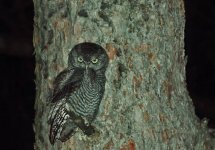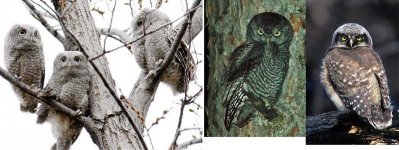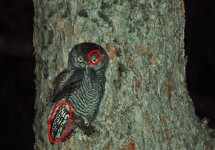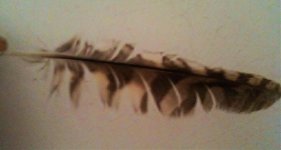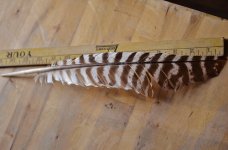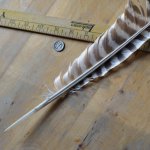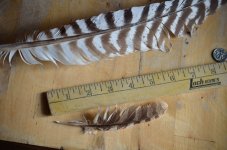-
Welcome to BirdForum, the internet's largest birding community with thousands of members from all over the world. The forums are dedicated to wild birds, birding, binoculars and equipment and all that goes with it.
Please register for an account to take part in the discussions in the forum, post your pictures in the gallery and more.
You are using an out of date browser. It may not display this or other websites correctly.
You should upgrade or use an alternative browser.
You should upgrade or use an alternative browser.
Owl ID wanted (Green Bay, Wi) (1 Viewer)
- Thread starter groony
- Start date
More options
Who Replied?Although the tail seems short, the horizontal vermiculations or striations on the breast and belly make this a Northern Hawk Owl.
lou salomon
the birdonist
maybe tail is still growing: a fresh juvenile northern hawk owl is my bet too.
By the way, good bird and a nice shot!
ntbirdman
Well-known member
This is a fledgling Eastern Screech-Owl. Definitely not a Hawk-Owl. Fledgling screeches have barred underparts, unlike adults and not often well illustrated in guides - but check NatGeo. Google image searches for "fledgling Eastern Screech-Owl" and "fledgling Northern Hawk-Owl" turn up good images of both for comparison.
This is a fledgling Eastern Screech-Owl. Definitely not a Hawk-Owl. Fledgling screeches have barred underparts, unlike adults and not often well illustrated in guides - but check NatGeo. Google image searches for "fledgling Eastern Screech-Owl" and "fledgling Northern Hawk-Owl" turn up good images of both for comparison.
First, it's not a fledgling per se, though it may be a juvenile. Second, absolutely no sign of 'ear' tufts whatsoever. I'll be interested to hear from others but I still say Hawk Owl ... I've been worng before though ... B
EBird has no records of Northern Hawk Owl for May through October for Wisconsin, and my guides do not show Wisconsin as being in their breeding range. So Northern Hawk Owl would seem unlikely.
However, the bird looks large for an Eastern Screech-Owl, and the apparent absence of ear tufts does seem odd given that the bird appears to be approaching maturity. But I have no better suggestions [edit: than ESO]. Here's one ESO photo that seems fairly close: http://www.flickr.com/photos/58684346@N00/1348758492/
Question for groony: Did you take this photo? Can you tell us any more about the circumstances, e.g. how did you know the bird was there? It appears to be taken at night.
Jim
However, the bird looks large for an Eastern Screech-Owl, and the apparent absence of ear tufts does seem odd given that the bird appears to be approaching maturity. But I have no better suggestions [edit: than ESO]. Here's one ESO photo that seems fairly close: http://www.flickr.com/photos/58684346@N00/1348758492/
Question for groony: Did you take this photo? Can you tell us any more about the circumstances, e.g. how did you know the bird was there? It appears to be taken at night.
Jim
Last edited:
ntbirdman
Well-known member
Alright, here's a comparison. I pulled the OP's picture and lined it up with two pictures pulled from google images (apologies to whoever owns the pics). Fledgling/juvenile Hawk Owl on the right, fledgling/juvenile ESOW on the left. The differences in structure and plumage should now be obvious.
On structure alone you can eliminate all the larger owls. The only potential confusion species for this location would be the small owls - other Megascops (none in Wisconsin) and Aegolius, but Saw-whets and Boreal have radically different juvenile plumage.
On plumage, look at the back and wing pattern closely. Dense brown vermiculations, and barring in the flight feathers. Compare that with the plain brown and white spots upper pattern on the hawk owl. Also, even on very young Hawk Owls the distinctive facial pattern is obvious - broad black borders on a white face. The Wisconsin bird has grey-brown vermiculations, like Screech-owls.
The lack of ear tufts is no problem at all. They are less developed on young birds, and they can be sleeked back. If the Wisconsin bird has them sleeked back, given the angle (looking down) you wouldn't even see them standing out against the rest of the crown.
I hope that helps.
Edit: I should add that I think you are right, Steve. The bird in question is more advanced than fledgling, but it's not adult plumage, so it's a juvenile.
On structure alone you can eliminate all the larger owls. The only potential confusion species for this location would be the small owls - other Megascops (none in Wisconsin) and Aegolius, but Saw-whets and Boreal have radically different juvenile plumage.
On plumage, look at the back and wing pattern closely. Dense brown vermiculations, and barring in the flight feathers. Compare that with the plain brown and white spots upper pattern on the hawk owl. Also, even on very young Hawk Owls the distinctive facial pattern is obvious - broad black borders on a white face. The Wisconsin bird has grey-brown vermiculations, like Screech-owls.
The lack of ear tufts is no problem at all. They are less developed on young birds, and they can be sleeked back. If the Wisconsin bird has them sleeked back, given the angle (looking down) you wouldn't even see them standing out against the rest of the crown.
I hope that helps.
Edit: I should add that I think you are right, Steve. The bird in question is more advanced than fledgling, but it's not adult plumage, so it's a juvenile.
Attachments
Last edited:
For whatever reason I didn't previously note the date of the photo (mid-summer). But, it still doesn't seem right for a screech owl. The head shape, as well as the suggestion of pronounced 'brow' just don't seem to fit a screech owl.
And to respectfully rebutt Jim .... A bit of time on Google finds the following from page 340 of
Wisconsin Birdlife: Population & Distribution Past & Present. 1991 By Samuel D. Robbins
"Status. Accident summer resident. Rare winter visitor." and note "Breeding data. Two records."
Suggests that NHO isn't completely out of the question.
And to respectfully rebutt Jim .... A bit of time on Google finds the following from page 340 of
Wisconsin Birdlife: Population & Distribution Past & Present. 1991 By Samuel D. Robbins
"Status. Accident summer resident. Rare winter visitor." and note "Breeding data. Two records."
Suggests that NHO isn't completely out of the question.
Last edited:
grebefeet9
elegant tern of phrase
the barring on the eyebrow would indicate a screech.
Last edited:
grebefeet9
elegant tern of phrase
Hello all, thanks for all the responses. Jim - the picture was taken at night, by a good friend in her backyard, smack dab in the middle of the city. She was able to get within about ten feet of the owl when the pic was taken. And it was only about ten feet high in the tree. Her son held a flashlight on it. And oddly enough, there was a (brood?) of young easily identifiable, readily seen Eastern Screeches in her neighborhood during the same time. But they looked nothing like this bird. I gave the pic to a good friend who knows her stuff, and she couldn't identify it. Subsequently she forwarded it to many experts across the country. And there was much debate amongst them as to whether it is an Eastern Screech, or Northern Hawk Owl. Hawk Owl was given slightly more votes.
I posted the pic on "the Owl Pages" on Facebook, and here is the response I received :
The Owl Pages It is an Eastern Screech owl - it is quite young, as indicated by the horizontal barring on the underside and the short tail. It is at a moult stage where the ear tufts are absent. This owl also has barring on the tail feathers of equal dark/pale bands, whereas Northern Hawk owl has dark tail feathers with thin pale barring. This owl also lacks the spotted forehead and broad dark edge of the facial disc that the Northern Hawk Owl has. These are my thoughts, I'd be interested in what the ornithologists say, please let us know!
I posted the pic on "the Owl Pages" on Facebook, and here is the response I received :
The Owl Pages It is an Eastern Screech owl - it is quite young, as indicated by the horizontal barring on the underside and the short tail. It is at a moult stage where the ear tufts are absent. This owl also has barring on the tail feathers of equal dark/pale bands, whereas Northern Hawk owl has dark tail feathers with thin pale barring. This owl also lacks the spotted forehead and broad dark edge of the facial disc that the Northern Hawk Owl has. These are my thoughts, I'd be interested in what the ornithologists say, please let us know!
ntbirdman
Well-known member
Perusing through google images, I came up with two more good juvenile Eastern Screech pics:
http://www.ohio-nature.com/image-files/screech-owl-family.jpg
http://graphics8.nytimes.com/images/2009/07/27/opinion/27owls.480.jpg
And also some adult Eastern Screech pics for variation in apparent head shape and ear appearance:
http://www.birdfinders.co.uk/images/texas-spring/eastern-screech-owl-texas-2008.jpg
http://www.lilibirds.com/gallery2/d/585-3/eastern_screech_owl+8.jpg
http://www.ctbirding.org/photos_owls/screech no tufts.jpg
http://www.ctbirding.org/photos_owls/screech red perched 3.jpg
And some more Northern Hawk Owl juveniles, to show how radically different they are from the Wisconsin bird:
http://photonaturalist.files.wordpr...perior-natl-forest-lake-co-mn-img_0021469.jpg
http://www.cartinafinland.fi/en/imagebank/image/82/82303/Northern+hawk+owl+juvenile+82303.jpg
http://www.ohio-nature.com/image-files/screech-owl-family.jpg
http://graphics8.nytimes.com/images/2009/07/27/opinion/27owls.480.jpg
And also some adult Eastern Screech pics for variation in apparent head shape and ear appearance:
http://www.birdfinders.co.uk/images/texas-spring/eastern-screech-owl-texas-2008.jpg
http://www.lilibirds.com/gallery2/d/585-3/eastern_screech_owl+8.jpg
http://www.ctbirding.org/photos_owls/screech no tufts.jpg
http://www.ctbirding.org/photos_owls/screech red perched 3.jpg
And some more Northern Hawk Owl juveniles, to show how radically different they are from the Wisconsin bird:
http://photonaturalist.files.wordpr...perior-natl-forest-lake-co-mn-img_0021469.jpg
http://www.cartinafinland.fi/en/imagebank/image/82/82303/Northern+hawk+owl+juvenile+82303.jpg
NTBIRDMAN,
What I find most interesting is the presence of juvenile screeches in the same yard during the same time frame. (there are pics, but not available right now. but they are definitely juvenile screeches - dead ringers for the pics you posted from Ohio-Nature.)
What would acount for the vast difference in appearance? And for fear of exposing my ignorance - is it possible this particular owl is some type of hybrid/cross-breed?
And what are the odds that ifthe bird in questionis a Northern Hawk Owl, that it just so happened to appear in the neighborhood during this particular time frame?
And...........the juvenile screeches had pronounced ear tufts!
What I find most interesting is the presence of juvenile screeches in the same yard during the same time frame. (there are pics, but not available right now. but they are definitely juvenile screeches - dead ringers for the pics you posted from Ohio-Nature.)
What would acount for the vast difference in appearance? And for fear of exposing my ignorance - is it possible this particular owl is some type of hybrid/cross-breed?
And what are the odds that ifthe bird in questionis a Northern Hawk Owl, that it just so happened to appear in the neighborhood during this particular time frame?
And...........the juvenile screeches had pronounced ear tufts!
Last edited:
ntbirdman
Well-known member
What would acount for the vast difference in appearance? And for fear of exposing my ignorance - is it possible this particular owl is some type of hybrid/cross-breed?
And what are the odds that ifthe bird in questionis a Northern Hawk Owl, that it just so happened to appear in the neighborhood during this particular time frame?
And...........the juvenile screeches had pronounced ear tufts!
Without seeing the pictures of the other juveniles, I can't account for any differences. I'd love to see those pictures if you get the opportunity to post them. I would guess that differences are primarily a result of age - the bird you posted has nearly all its adult feathers, in fact the only immediate clue to it being a juvenile is the underparts pattern. Younger birds would have a lot more fluff and less adult feathers. Another potential difference would be color morph.
In plumage and structure, your bird is perfect for eastern screech-owl. There is nothing about it that suggests hybrid with any other genus of owl. It could, in theory, be another screech-owl species or a hybrid, but Eastern is the only expected screech owl in Wisconsin. Then next closest species is Western, which only comes as close to Wisconsin as Colorado. The only differences between Eastern and Western at that age (at least according to the sources I just checked) is bill color, and your bird matches Eastern. So, there's no reason to invoke a hybrid hypothesis.
There is a zero percent chance that your bird is a Hawk-Owl.
As I mentioned, (apparent) lack of ear tufts is no strike against Eastern screech. The somewhat odd head shape that people note on your bird is simply caused by it looking down to preen its upper breast. If there are sleeked-back ear tufts on this bird, they would not stand out from this angle.
Fire away with more questions if you've got 'em.
Cheers,
Nick
Thanks for the response. It makes sense to me. I think you're correct concerning the age difference. The other birds did appear smaller, with fluff.
I have sent a request for the other pics. I will post when I receive.
On a side note, she also has at least 1 Great Horned that frequents her backyard pretty regularly, lately.
Much thanks :t:
I have sent a request for the other pics. I will post when I receive.
On a side note, she also has at least 1 Great Horned that frequents her backyard pretty regularly, lately.
Much thanks :t:
Last edited:
Littlefeebe
New member
the mystery
These are my summer friends flew around my head ...fun to see the many whoooo want to see who they are. I indeed forgot the feather of my 3 friends. i will post the pic. -I believe it is the answer -Eastern screech
These are my summer friends flew around my head ...fun to see the many whoooo want to see who they are. I indeed forgot the feather of my 3 friends. i will post the pic. -I believe it is the answer -Eastern screech
Littlefeebe
New member
Littlefeebe
New member
I found a feather in my yard yesterday ...a clue perhaps. I also made a visit to The Wild Life Sanctuary ..and I am indeed 100% certain these juvenile owls are not screech. The 3 owls were app. 3 - 4 months old when I captured the photo and they were at least a foot from head to tail feathers.-here are the feathers I have found around the yard
Attachments
Users who are viewing this thread
Total: 2 (members: 0, guests: 2)




